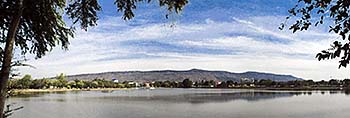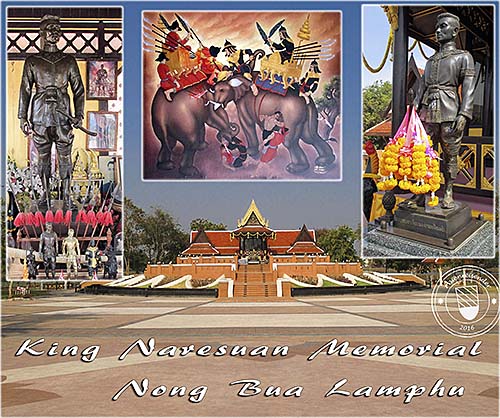
1.
Nong Bua Lamphu
Nong Bua Lamphu is a small place at the western edge of Isan. It's as well a town as a province capital of a province with the same name. The province is among the newests in Thailand, in existence as such since 1993. Before, the area belonged to Udon Thani Province.
Phu Kradung Formation

The mountains northeast of town. Urbanization is creeping up the slopes, particularly along highway 210. In the foreground lies Nong Bua, the namegiving lake. Image by Asienreisender, 1/2016
Nong Bua Lamphu is connected by highway 210 to Udon Thani Province. In contrast to the most other places in Isan, Nong Bua Lamphu lies in a mountainous surrounding, at the foot of the Phu Chan Mountains. It's a small place where one can easily walk from one end to the other (but has to mind the many semi-ferocious dogs in the sideroads). Due to the mountains and the relative isolation of the place from the plains of the Khorat Plateau, Nong Bua Lamphu is different than the other places in Isan. It's hard to describe, and one needs certainly longer to learn more on the people's mentality, but it reminds me somehow to north Laos. A bit more fraudulent than normal, it seems.
The Phu Chan Mountain Range

The mountain slopes of the Phu Chan Range, who lie between Nong Bua Lamphu and Udon Thani Province, lower into a high plain. On their southwestern foot Nong Bua Lamphu lies. The place is therefore geographically isolated from other places in Isan. West of town the area is more mountainous - the higher Phetchabun Range follows and separates the region from central Thailand.
The small vertical white shape on the opposite slope is a buddhist stupa. Religious monuments and buddhist temples are often the first pioneers who come in advance to further urbanization. With the temple comes a first road, traffic, people, din, pollution and the blasted dogs who hunt the wildlife in the forests. The vertical stripe right to the stupa is a forest road. Image by Asienreisender, 1/2016
King Naresuan Memorial

On a large square at the shores of Nong Bua stands this pompous royal memorial. It's remarkable how much resources are spent for the glorification of kings in Thailand. In addition to this building with two metal statues of Naresuan there is another memorial for the same king at the Shell Fossil Museum in the mountains. Among the paintings there is that with the legendary elephant fight against the Burmese crownprince Minchit Sra in 1593.
King Naresuan was a decisive military leader already in the years before he became king. After Ayutthaya fell into Burmese hands in 1569, Naresuan and his brother were taken to Burma as hostages. Nevertheless, they enjoyed a qualified military education there. In 1571 they were allowed to come back to Siam, where Naresuan became governor of Phitsanulok. He defended Siam against Khmer armies who tried to take advantage of Siam's difficult position at the time. In accordance with his father, the then king Phrachao Sanphet I of Ayutthaya, Naresuan cancelled the vasallage against the Burmese. That triggered another war in which two Burmese armies tried to conquer Ayutthaya again.
Although the Burmese were considerably stronger in number and also better equipped, Naresuan succeeded to defend Siam's coreland in using a guerilla tactics, withdrawing and unexpectedly attacking quickly, leaving the Burmese only scorched earth. In a years-long succession of wars the Siamese army finally conquered three places on Burmese territory at the shores of the Andaman Sea.
Afterwards Naresuan conquered Cambodia in 1593 and made the Cambodian royal family fleeing to Viang Chan (Vientiane). That broke finally the military power of Siam's Cambodian rival in the east.
King Naresuan is seen as one of the most gifted military leaders in Southeast Asia's history. Images and photocomposition by Asienreisender, 1/2016
Namegiving was certainly the bigger lake Nong Bua in town, close to the city's main road. The lake is also a recreational place where one can do sports and use some facilities. At the lake's shore is also a shrine built to honor king Naresuan of Ayutthaya (reign: 1590-1605), who regained Siam's independence after years of Burmese occupation. Famous is a duel between Naresuan and a Burmese prince in battle. Since in the 16th century Lanna and north Laos were under Burmese control, the border between Siam and Burma run through the land here at Nong Bua Lamphu.
About ten kilometers out of town in the mountains lies the very attractive Shell Fossil Museum. A number of fossils, from the beginning of life on earth and from the Jurassic Period (about 140 - 150 million years ago) have been found here in the ground. The main museum consists of one building with only one big room, but it gives a good introduction into these two developing stages of life on earth. The discovery of fossils has been made at a quarry in the mountains.
However, Nong Bua Lamphu is not at all a touristic place, lies off the main traffic routes and does not appear in the travel guides. I spent two hours in the museum and only when I left appeared three young Thais.
Shell Fossil Museum / Nong Bua Lamphu

Isan is dinosaur land. Almost all of the findings of dinosaurs in Thailand, and moreover in whole Southeast Asia, have been made in Isan. There are only two exceptions - one in Phetchabun, what is not far west of here, and another one in Phayao, north Thailand. Why is that so? Well, it has to do with the geohistorical peculiarity of Isan (see also: 'The Dinosaur Museum of Kalasin' and 'Isan in the Mesozoic Era').
One of the most prominent dinosaurs, the Tyrannosaurus rex (1), has an ancestor in Isan: it's Siamotyrannus isanensis. In the museum is a real-size model of the lizard placed what is so realistic that it can scare. Particularly since it has a hydraulic what makes it moving and crying in a most lively kind.
Another regional star is Phuwiangosaurus sirindhornae (2), a herbivorous giant which is seen as the largest land animal which ever lived. The first who was discovered of this species was found in nearby Khon Kaen Province. It's 15m to 20m long and lived in the time around 130 million years ago.
A heavy and scurille fellow is the triceratops (3). Among exhibition pieces are also dinosaur eggs (4). They have a diameter of about 20cm (these ones are replicas). Another finding are the fingerbones of a large dinosaur (5).
Living things all die, and after death they usually decompose very quickly. Fossils therefore didn't, and that is a very rare exception. Particularly when they remain conserved for a long, long time, say, over many millions of years (6). When such fossils are found, they are an incredible valuable source for solving the puzzle of life's history on earth. All of their details are of importance, means the position and surrounding of their finding place. Bringing them in a disorder means an irreparable loss of valuable information. Unfortunately, most fossils are found at building sites, and in the rush of our times it means just an unwanted trouble for those who build to care for them. Most of them get destroyed, lost for ever for science and the knowledge of mankind. However, it's everyone's duty to announce the finding of fossils to the authorities in Thailand, following the 'Fossil Protection Act'. Violation of the law shall be fined with an amount of 50,000 baht. However, particularly big money will easily find a way to bail out, and 50,000 baht are not so much for them, after all...
Molluscs are a group of species who live since the Cambrian period (540 million years ago). They are aquatic animals with a nervous system and a digestive system. Molluscs live in freshwater as well as in saltwater. They might leave shallow waters and cling at certain spots, as often to see at piers or seashore rocks. The molluscs found in the area of the Shell Fossil Museum (7) (Ban Huai Dua) are of the class Bivalvia.
In the times 150 to 120 million years ago at this area was a freshwater hole (might have been a marsh, pond or lake) in which pockets of bivalves lived. In a flood with strong currents molluscs were burried by sediments and gravel. The smothered shells died and turned into stone fossils. Millions of years later an enormous tectonic pressure shaped the mountains of the Phu Chan Range.
In 1994 local people found fossils in a quarry. The mollusc fossils here are burried in a depth of 15m in the ground, two meters below the sedimentary rock in which the dinosaur fossils were found.
The quarry where the fossils were found (8). A few paths lead throught the forested surroundings. There were also dinosaur footprints excavated in the area.
Dont' feel too safe when walking around here in the forests. It happens, here and there, that one of the ancient lizards suddenly appears, waiting behind a tree or a bush... (9). Congratulations to those, who made the museum. It's by far not the worst I have seen.
Images and photocomposition by Asienreisender, 1/2016
Wat Sri Koon Muang
The modern center of town lies on the highway to Chum Phae. The old part of town seems to be that north of highway 210. Close to the main road is also the city pillar shrine (lak mueang) placed, what usually marks the town's center. Here it looks perfectly for Thai village life. The most prominent temple site here is Wat Sri Koon Muang, which has a few rare tablet stones on it's ground. What I saw looks pretty much for Dvaravati border stones, but there is no explanation given, and asking the monks is usually futile. Here I found also a few cages with animals, of who some are from the surrounding mountains and others are rabbits and guinea pigs and budgies who are of South American or European decent.
The Animals of Wat Sri Koon Muang

It's always a pity to see animals in cages. It all wasn't too clean and the nice fellow bottom right had no water. I went to the monks and asked them for water. One of them brought two bottles and poured them into a bowl, while others were only laughing. It seems that the civet cat is from the mountains, and allegedly there were many of them. Sometimes they come into the gardens in the outskirts of the town, and people occasionally bring one to the temple. These buddhist temples are well known as animal shelters, particularly for dogs and also for cats. Here also some wild animals are brought. The monk told me that he had another civet before, but it was killed by a dog. That does not sound good - how comes? Besides, he said, he would expect soon getting another civet. He estimated this one of 6kg of weight.
That all does sound alarming. Chances are high, that the animal will be sold. Civets are among many other animals who are favoured by many Chinese as medicine or just as an exotic food.
Next morning I came again with some chicken remains to feed the fellow. I don't know if that triggered the activity, but suddenly a group of monks started to clean the bigger cages with water and feeding the animals.
I have to blame the monks for being not anyhow convincing as spiritual people. What I saw here, together with many other dubious and often scandalous experiences all around in Thailand, they seem to me always merely as a certain kind of businessmen. Their merchandise is bogus and sometimes more - like these poor animals, kids, women, drugs, weapons...
The butterfly, in the temple's garden, was the only free creature I saw there.
Images and photocomposition by Asienreisender, 1/2016
2.
The History of Nong Bua Lamphu
The place was allegedly mentioned in historical records first time in about 1100 CE. It probably was then anyhow under the dominance of the empire of Angkor (?!). In later centuries it became a Laotian place, at least as a tributary. In 1574 it was conquered by Siamese troops under king Maha Thammaracha and his son, king Naresuan. Nong Bua Lamphu was a base of the Siamese army for further advance into the Laotian kingdom of Lan Chang. These events were part of the struggle between Siam and the Burmese kingdom of Taungoo.
In the years after the downfall of Ayutthaya the place suffered turmoil. Two different Laotian factions fought a battle here and the place was partially destroyed and (maybe) abandoned. New resettlement and reconstruction followed from 1905 on, when the town got it's contemporary name.